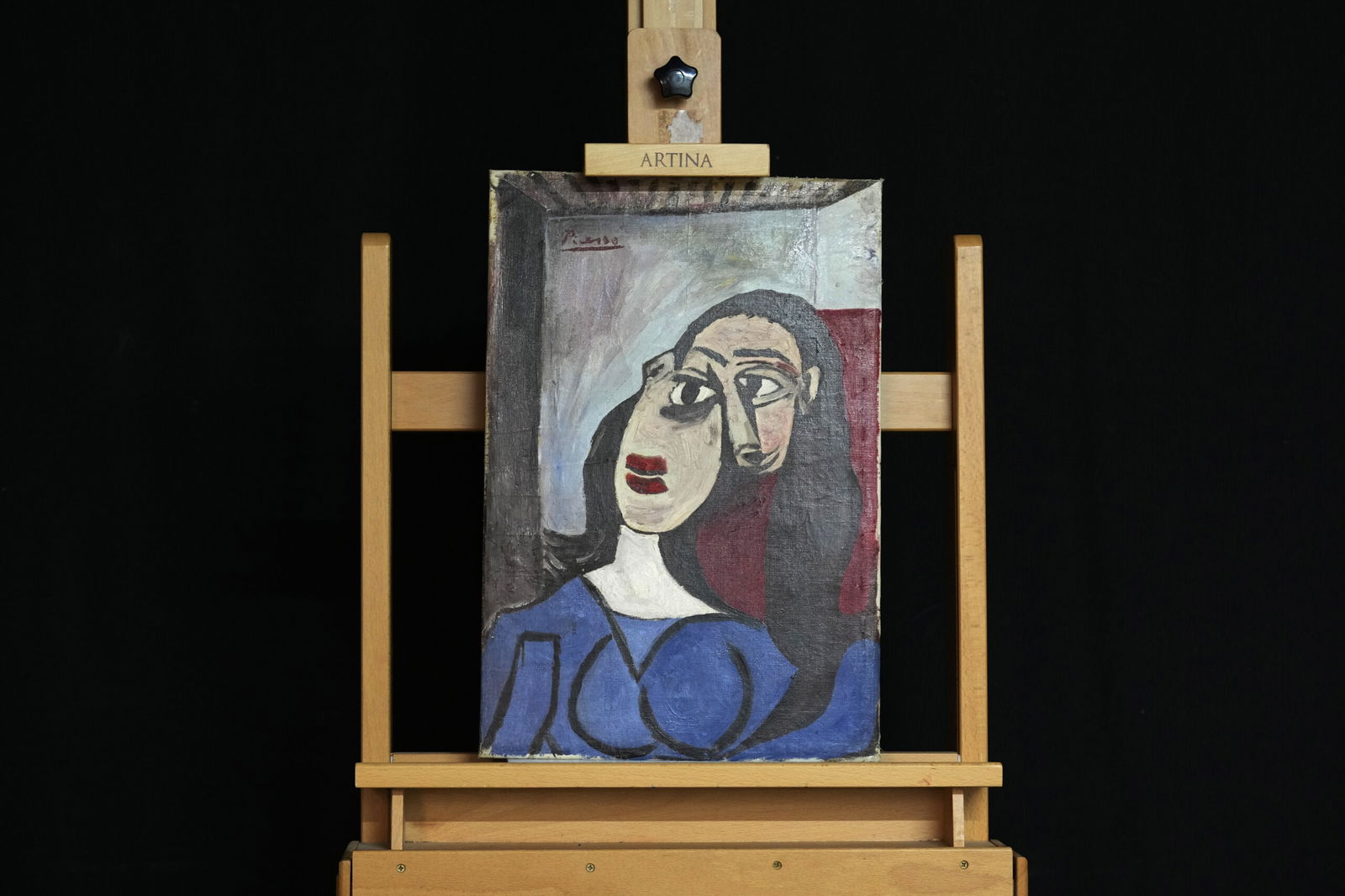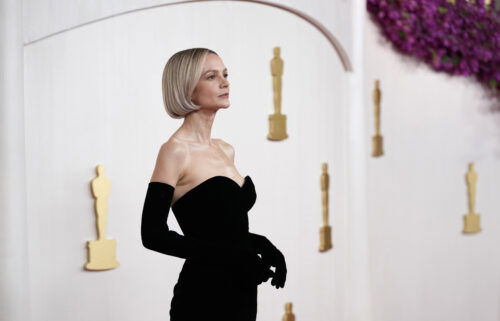Guilty Pleasures

By Associated Press
Italian family believes painting found in a dump in 1960s is a Picasso and seeks authentication
MILAN | An Italian family hopes to prove definitively that a painting discarded from a villa on the island of Capri more than 60 years ago is a Picasso, and has been gathering scientific data to persuade Picasso’s estate administration in Paris to make the definitive call.
The rolled-up canvas of a female figure was discovered in a pile of trash that a junk dealer was hired to discard in the early 1960s, and it hung innocuously in the family living room and then restaurant in Pompei, near Naples, for years until his son decided to investigate.
“My mother called it ugly,” the junk dealer’s son, Andrea Lo Russo, said Thursday. “Here, we are used to landscapes featuring the sea.”
Lo Russo said that his first inkling that the painting may be an important work came when he saw a Picasso in a middle school textbook, but neither his teacher nor his father were persuaded. His curiosity persisted, and in his early 20s, he and his brother drove to Paris and brought the painting to the Picasso Museum.
“They looked, and they said, ‘It is not possible,’” Lo Russo recalled. He said that he declined their invitation to leave the painting for further examination, not wanting to relinquish it.
Over the years, Lo Russo said that his attempts to verify the painting exposed him to fraudsters who tricked him out of money, and even landed him under investigation for suspicion of trafficking in forged art — which was dropped after he produced paperwork showing his attempts to verify the painting’s origin.
After decades of trying to determine the painting’s provenance, Lo Russo believes that a recent battery of tests carried out by the Swiss-based Arcadia Foundation finally offers proof that it’s the work of Picasso.
They include lab tests that show the paints used were consistent with Picasso’s color palette during the period in question, said Luca Marcante, a trained chemist who founded the Arcadia Foundation in 2000 to investigate the provenance of artworks. Most recently, a handwriting expert authenticated the signature on the upper-left hand corner as that of Picasso, Marcante said.
The only entity that can authenticate the painting is the Picasso Administration in Paris. It hasn’t responded to a series of inquires over the years. Marcante said that he’s preparing to share the most recent findings with them.
“You need to understand, they get dozens of inquiries every day from private people believing they have found a Picasso,’’ Marcante said.
Contacted by The Associated Press, the Picasso Administration declined to comment on the case.
Marcante put the value of the painting at 6 million euros ($6.6 million), but said that if fully authenticated, it would soar to 10-12 million euros. After years of hanging casually in the Lo Rosso family home, it’s now in a vault in Milan.
Marcante said that the painting is strikingly similar to a 1949 painting attributed to Picasso called “Tete du femme,’’ which is included in the online Picasso Project curated by the Sam Houston State University in Texas.
Marcante said that there is photographic proof Picasso visited the ruins of Pompeii in 1917, and asserts that he likely also visited nearby Capri, where he may have painted the Lo Russo-owned canvas sometime in the early 1940s, leaving it behind “forgotten in time.”
Marcante is convinced that the found painting isn’t a forgery, because of the differences between the two, including different ceilings, and a missing edge on the seat.
The painting “Tete du femme,” appears to be of Picasso’s one-time lover Dora Maar, given the dark hair and dark eyes, according to Enrique Mallen, the Picasso scholar who runs the online project. He cast doubt on the theory that Picasso would have created two paintings that were so similar.
“From what I know of studying Picasso for 30 years, he would never do an identical copy of his own work,’’ Mallen told The Associated Press. “He was quoted as saying, ‘You can copy anyone expect yourself.’”
The only record of “Tete du femme” was in a 1967 book, where it was listed as being in a private collection in Turin. It has never turned up in other references, Mallen said.
Mallen underlined that his online database, which numbers more than 41,000 Picasso entries, assembles images of paintings, sculptures, drawings and other works attributed to the artist, but doesn’t attest to their authentication — something only the Picasso Administration can do.
Marcante called the “Tete du femme” “a ghost painting, because no one has ever seen it.”
“The only real one is ours, that we have examined in a scientific manner. We are convinced of our work, and of the results science has given us,” Marcante said. “We can touch this painting with our hands. It is real, it is authentic.”
If the painting his father discovered is confirmed to be a Picasso, Lo Russo said that the family is still trying to figure out if they would sell it, caught in a whirlwind of inquiries since news of the painting’s suspected provenance surfaced this week.
“We are confused ourselves,” he said.
After 31 years, a French treasure hunt may have a winner. The prize: a valuable golden owl
PARIS | A 31-year-long treasure hunt that drew in thousands of enthusiasts across France appeared to have come to an end Thursday, after official social media accounts linked to the search said the token needed to claim the grand prize had been found.
The hunt, “On the Trail of the Golden Owl,” was based on a book of riddles published in 1993. Participants had to solve 11 puzzles in the book — and a 12th one that was hidden — to decipher the exact location of the token.
“Don’t go digging!” warned a message on a channel on the chat app Discord with tens of thousands of followers. “We confirm that the Golden Owl countermark was unearthed last night,” the message read, unleashing a wave of sad and crying emojis. “It is therefore useless to go digging.”
The solutions provided by those who claimed to have unearthed the token were currently being vetted, the message said.
The book, published in 1993 by author Régis Hauser and artist Michel Becker, built a cult-like following with a community of more than 200,000 players, known as “owlers,” from France and abroad, according to the hunt’s official website.
In a documentary posted on YouTube, Becker said he oversaw and financed the creation of the prize, an owl made of 3 kilograms (6 pounds, 10 ounces) of gold and 7 kilograms (15 pounds, 7 ounces) of silver with diamond chips on its face.
Events where “owlers” could meet and share tips were organized across France.
Hauser, the intellectual architect of the riddles, had initially used the pen name Max Valentin to prevent the most assiduous treasure hunters from seeking him out. He died in 2009, French newspaper Le Monde reported.
He and Becker decided to bury a replica of the owl, keeping the precious original in a safe place. Its value is currently estimated at 150,000 euros (about 165,000 dollars), fans of the treasure hunt have said online and at recorded events.
In order to claim the treasure, the winning player would need to submit the replica along with the answers to all of the book’s enigmas.
Becker did not respond to a request for comment from The Associated Press.
On Discord, members of the hunt channel were quick to react to the news that the replica owl may have been found, with thousands of messages pouring in.
“Time to get the tissues out,” one wrote. “It’s the end of an era,” said another.
French media outlets also marked the end of the three decade-long chase, one of the world’s longest unsolved scavenger hunts. “I’m disappointed because I thought I was close but at the same time relieved that it’s stopping,” one participant from the south of France said on France Inter radio.
The 30-year-old man said he had spent all his weekends searching for the owl over the past two years, and had at times found himself digging in the middle of the night.
On the official website, Becker reminds “owlers” not to dig holes on either public or private property without authorization.
According to a 2021 documentary, the concept was inspired by The Masquerade, a 1979 book of riddles by Kit Williams, where hunters also had to solve several enigmas to find a golden rabbit.
A new initiative will allow UK deaf audiences to see captioned films before general release
LONDON | For once, deaf audiences are being prioritized at U.K. cinemas.
Paramount Pictures UK will be showing their movies with captions the day before general release, meaning deaf and hard of hearing cinemagoers across the country will be able to watch them first.
The distributor is starting with the robot animation “Transformers One” on Oct. 10. Subtitled screenings of Paramount’s upcoming films, “Gladiator II,” “Sonic the Hedgehog 3” and “The Smurfs Movie,” will follow over the next few months.
Rebecca Mansell, chief executive of the British Deaf Association, called the initiative ground-breaking. Deaf, deafened and hard of hearing audiences have been struggling to attend the few available subtitled film showings because they are often scheduled at inconvenient times, she said.
“It fits in with the cinema’s needs, but not necessarily when the Deaf community want to go,” she said. “The deaf community always feel that they are the last ones to know, the last ones to watch something, the last ones for everything. And now we’re going to be the first. It’s definitely a really exciting moment.”
Around 18 million people in the U.K. are registered as deaf, deafened or hard of hearing, according to the association.
Paramount has also been running deaf awareness training with cinema managers and staff in U.K. cities so that they can better communicate with customers.
Yvonne Cobb, a TV presenter and celebrity ambassador for the British Deaf Association, was running the training at a large cinema in central London’s Leicester Square Wednesday.
She said the three-hour training session wasn’t enough for staff to become fluent in British Sign Language, but workers were able to learn basic signs, how to interact with deaf customers and what not to do — for example shouting or covering one’s mouth. They were also taught how to spell with their fingers to indicate the name of the movie.
“We taught the staff how to say the number of which screen it’s in, and also some greeting signs as well — for example ‘how are you?’,” said Cobb, who is a qualified British Sign Language teacher.
Paul Johnston-Naylor, a general manager at Feltham Cineworld, completed the training on Wednesday and said that learning the British Sign Language alphabet was very useful.
“We can try and finger spell some of the names of the movies and then some of the common phrases that we would probably use in the cinema industry, to help the customer navigate their way through the cinema, buy their popcorn, go and sit in a screen and find their seats,” he said.
Cobb even invented a new sign for “Transformers One” that was inspired by the robot characters like Optimus Prime and Megatron.
Mansell also notes that subtitles are becoming increasingly popular with younger generations.
“60% of young people prefer watching things with subtitles,” she said. “I think before, people view them as being in the way or ruining the image. And now they’re a lot more accepted and a lot more normalized.”
The Grammys’ voting body is more diverse, with 66% new members. What does it mean for the awards?
NEW YORK | For years, the Grammy Awards have been criticized over a lack of diversity — artists of color and women left out of top prizes; rap and contemporary R&B stars ignored — a reflection of the Recording Academy’s electorate. An evolving voting body, 66% of whom have joined in the last five years, is working to remedy that.
At last year’s awards, women dominated the major categories; every televised competitive Grammy went to at least one woman. It stems from a commitment the Recording Academy made five years ago: In 2019, the Academy announced it would add 2,500 women to its voting body by 2025. Under the Grammys’ new membership model, the Recording Academy has surpassed that figure ahead of the deadline: More than 3,000 female voting members have been added, it announced Thursday.
“It’s definitely something that we’re all very proud of,” Harvey Mason Jr., academy president and CEO, told The Associated Press. “It tells me that we were severely underrepresented in that area.”
Reform at the Record Academy dates back to the creation of a task force focused on inclusion and diversity after a previous CEO, Neil Portnow, made comments belittling women at the height of the #MeToo movement.
Since 2019, approximately 8,700 new members have been added to the voting body. In total, there are now more than 16,000 members and more than 13,000 of them are voting members, up from about 14,000 in 2023 (11,000 of which were voting members). In that time, the academy has increased its number of members who identify as people of color by 63%.
“It’s not an all-new voting body,” Mason assures. “We’re very specific and intentional in who we asked to be a part of our academy by listening and learning from different genres and different groups that felt like they were being overlooked, or they weren’t being heard.”
Mason says that in the last five years, the Recording Academy has “requalified 100% of our members, which is a huge step.” There are voters who have let their membership lapse — and those who no longer qualify to be a voting member have been removed.
There have been renewal review processes in the past, but under the current model, becoming a voting member requires proof of a primary career in music, two recommendations from industry peers and 12 credits in a single creative profession, at least five of which must be from the last five years.
Comparisons might be made to the Academy of Motion Picture Arts and Sciences, which announced in 2016 that it would restrict Oscars voting privileges to active members — ineligible parties included those who haven’t worked in three decades since joining the Academy, unless they themselves are nominated — as a response to #OscarsSoWhite criticisms of its lack of diversity. As a result, some members protested that the new measures unjustly scapegoated older academy members. The film academy has also grown its membership, adding more women and people from underrepresented racial and ethnic communities.
The Recording Academy sought to increase its voting body by reaching out to different, underrepresented communities, says Mason. “Let’s take the time to understand why those people aren’t engaging with us, figure out how we can fix that,” he said. “And once we fixed it, then let’s invite them or ask them if they would like to be a part of our organization. So, it was a multi-step process.”
Since 2019, the Recording Academy has also seen growth in voters across different racial backgrounds: 100% growth in AAPI voters, 90% growth in Black voters and 43% growth in Latino voters.
Still, Mason sees room to grow. Of the current voting membership, 66% are men, 49% are white and 66% are over the age of 40.
“Going forward, we’re going to continue the work. We’re going to continue to grow,” he says.
That might not look like a public commitment to a specific figure, but Mason promises “that our goals will be to be the most relevant, the most reflective, the most accurately representative of the music community that is humanly possible.”
—From AP reports


